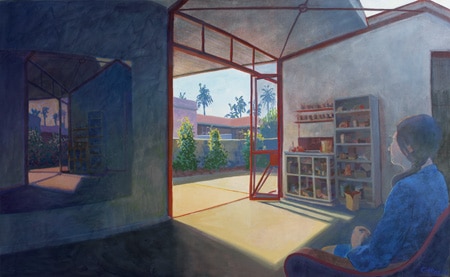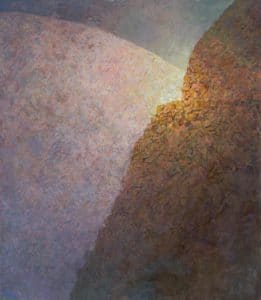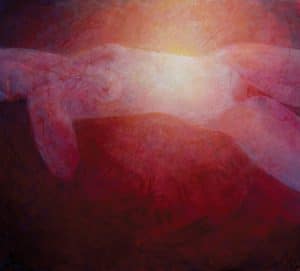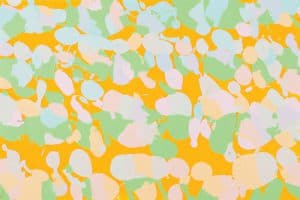If there’s a world record for the run down “The Mall” between Admiralty Arch and Backingham Palace, George Hayns probably holds it – at 3am on a summers morn, his borrowed motor bike (a Norton Dominator) hit a hundred miles per hour before he applied the breaks so the roundabout fronting the palace couldn’t claim him – “Breaking was the hard part,” he recalls. The year was 1962 and he was in London studying at the Chelsea School of Art.

That youthful act of bravura fits my opinion of Haynes’ attitude to painting – rules and laws are guides – if the need arises bend them. I’ve never shared this opinion with George and I’m uncertain how he would respond – but I know that he’s still having difficulty with his breaking.
During the mid 70’s following the closure of the Skinner Gallery, an auction of work by Contemporary Western Australian artists was held on a Saturday morning in the upstairs rooms of Gregsons the Auctioneers of Beaufort Street.
Gallery G the rooms were know as then, and local artists seeking to fill the void caused by Rose Skinner’s passing started it.
Haynes, Robert Juniper, David Gregson and a few others had entered works for sale – Interest was minimal and there were probably more sellers at the auction than buyers. Some of Haynes’ pictures were bid to as little as $50 that day and other painters didn’t fare any better either. Gallery G closed soon after, for reasons related to staffing.
George’s pictures came to my notice at that viewing. While I could readily identify work by others, his were different. There didn’t seem to be a common thread. No two pictures appeared the same, and I was continually referring to the gestetnered catalogue to discover whose work it was – time and time again the name George Haynes appeared.

Landscapes, nudes, street scenes, still life, interiors and abstract – all by him were packed into that room. His colour was unique and used in a non-conventional (to me) manner. Blue trees, red water, green nudes and purple chairs were the norm and occasionally there would be a small traditional landscape, just to add to the mix.
It was a tough sale and the auctioneer became a bit fractious, as piece after piece was reffered. And not being confident inmy judgement, the urge to acquire was quashed – so I left the auction Haynesless and a few others less as well. It was a day when a thousand dollars would have bought a lot and some major pieces could be had for a trifle – but the eye was new, the atmosphere dark, so the opportunity passed by.
The next time I saw Haynes work in volume, was again at auction – it was early 80’s and the PIFT theatre in Fremantle was the venue.
George was building a new studio and he had to sell some pictures to pay for it.
Auctions like these can often be the source of bargains and as confidence in my judgement was no longer an issue – to inspect those on offer was a must – I wasn’t going to let the opportunity pass me by again.
Dazzling reds, subtle violet, luminous greens and glaring yellows were all there – blue nudes, green houses, pink boats and though the palette had a post impressionism feel, the texture didn’t – the images weren’t obviously distorted either, and all communal tastes seemed catered for. I circled at least twenty that I wanted.
Audience awareness was poles apart to the Gallery G experience. The viewing was strong and the interest was genuine.
George was present, talking, listening and explaining – I was amused by the artiness of it all.

Wine was plentiful but glasses were not and the waiters were sipping more than they were serving.
It was an enjoyable and different way to spend a Sunday afternoon in Perth in the 80’s – quite bohemian it seemed.
By the time the auction was due to start, the room was packed to standing room only. Bob Gregson was in charge, and before he commenced, a young lady in an interesting costume slithered out front and performed an exotic dance that was greeted politely in some areas, and enthusiastically in others – such was the diversity of the audience.
George’s friends were buoyant throughout though – and the noise from that corner became louder and louder as the day progressed. It all added to the atmosphere and probably explained the shortage of wine glasses.
From the beginning, bedding was brisk and some solid prices were paid. I waved my hand at everything I wanted and not till near the end was I able to land one – a little (almost) mono chromatic oil on panel titled Reabold Hill – it was unsigned, but that didn’t matter as the artist was to hand – I was doubly pleased as my Sunday hadn’t been a waste and I thought I’d secured one of the bargains of the day.
I was introduced to George following the auction and asked if he would sign the work “How much did you pay?” he inquired, “Two Hundred” I replied. “I could have sold that to Heindrick for four hundred” he said, “He wanted to buy it just recently and I didn’t want to sell.” He remonstrated with himself; mumbled something inaudible and signed the picture on the reverse. I never discovered who Heindrick was. I think I was supposed to know.

Twenty years passed before I met George again, though I kept in touch with his work through his retrospective, numerous exhibitions, auctions and ownership.
I have come to understand that George is a painter – often a sculptor and more recently an etcher.
He receives ideas from wherever he travels – understands the craft of his art – doesn’t create to satisfy market demand – is baffled at the correlation between title and saleability – has a strong work ethic and will not let an unresolved piece leave the studio.
George proclaims himself as the sole member world wide of the Illuminism Group of artists.
One maybe two hundred pictures pass me by every week, and whenever I see an interesting work in a semi-familiar manner I always ask for details of the author – invariably the reply is George Haynes – something different again – why do I continue to be surprised?
– IMF 2007

